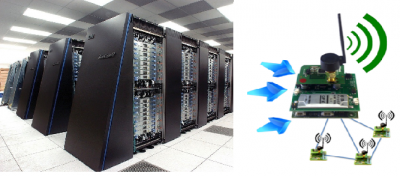Difference between revisions of "A Wireless Sensor Network for a Smart Building Monitor and Control"
From iis-projects
| Line 1: | Line 1: | ||
| − | [[File: | + | [[File:HPC wsn.png|400px|right|thumb]] |
==Short Description== | ==Short Description== | ||
| − | The rapid progress of wireless communications and embedded technologies has made wireless sensor and actuator networks (WSANs) possible. These networks are distributed system consisting of nodes with sensors | + | The rapid progress of wireless communications and embedded technologies has made wireless sensor and actuator networks (WSANs) possible. These networks are distributed system consisting of nodes with sensors interconnected by wireless links. We want to apply this scenario to a High Performance Computing (HPC) infrastructure for environmental monitoring, aiming at an improving of the overall energy efficiency. |
| + | |||
| + | The main goal of this project is to work in hardware and software to design a wireless sensor network to monitor several metrics (e.g. temperature, humidity, fan vibration, etc.) and send the data to a central gateway. The data can be in ultimate correlated with other metrics which are already collected by an existing monitoring infrastructure (e.g. power consumption, and other architectural metrics, like cache miss, hits, etc.) to apply machine learning algorithms for an energy efficiency improvement and HPC infrastructure maintenance. The candidate will work with a micro-controllers and Radio transceiver (for example CC2650 from Texas Instruments) at firmware level to build up the network. The network protocol can be Bluetooth or Zigbee. The hardware part can include also a redesign and optimization of the nodes' boards to build an ad-hoc solution with a small form factor and with only the needed components. The machine learning algorithms on top of the collected data can be part of the thesis according with the skills of the candidate students. Measurements of the system will be performed from the students in order to evaluate power consumption reduction, reliability, functionality and optimize the system. | ||
| − | |||
===Status: Available === | ===Status: Available === | ||
* Looking for Semester and Master Project Students | * Looking for Semester and Master Project Students | ||
| − | : Supervisors: [[:User:magnom|Michele Magno]] | + | : Supervisors: [[:User:Libria | Antonio Libri]], [[:User:magnom|Michele Magno]], [[:User:Barandre | Andrea Bartolini]] |
===Prerequisites=== | ===Prerequisites=== | ||
| − | : C Language | + | : C/C++ Language |
: Interest in Computer Architectures at system level | : Interest in Computer Architectures at system level | ||
| − | |||
: Knowledge of machine learning would be beneficial. | : Knowledge of machine learning would be beneficial. | ||
Revision as of 16:02, 1 September 2017
Contents
Short Description
The rapid progress of wireless communications and embedded technologies has made wireless sensor and actuator networks (WSANs) possible. These networks are distributed system consisting of nodes with sensors interconnected by wireless links. We want to apply this scenario to a High Performance Computing (HPC) infrastructure for environmental monitoring, aiming at an improving of the overall energy efficiency.
The main goal of this project is to work in hardware and software to design a wireless sensor network to monitor several metrics (e.g. temperature, humidity, fan vibration, etc.) and send the data to a central gateway. The data can be in ultimate correlated with other metrics which are already collected by an existing monitoring infrastructure (e.g. power consumption, and other architectural metrics, like cache miss, hits, etc.) to apply machine learning algorithms for an energy efficiency improvement and HPC infrastructure maintenance. The candidate will work with a micro-controllers and Radio transceiver (for example CC2650 from Texas Instruments) at firmware level to build up the network. The network protocol can be Bluetooth or Zigbee. The hardware part can include also a redesign and optimization of the nodes' boards to build an ad-hoc solution with a small form factor and with only the needed components. The machine learning algorithms on top of the collected data can be part of the thesis according with the skills of the candidate students. Measurements of the system will be performed from the students in order to evaluate power consumption reduction, reliability, functionality and optimize the system.
Status: Available
- Looking for Semester and Master Project Students
- Supervisors: Antonio Libri, Michele Magno, Andrea Bartolini
Prerequisites
- C/C++ Language
- Interest in Computer Architectures at system level
- Knowledge of machine learning would be beneficial.
Character
- 30% Theory
- 50% Implementation
- 20% Testing
